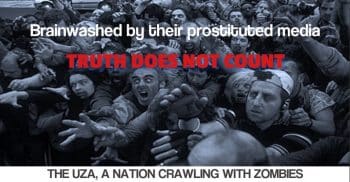Is the NYT rethinking Russia – at least temporarily?
Dispatches from Deena Stryker
Amid 24/7 agitation over Russia’s supposed role in Hillary Clinton’s presidential defeat, last week, the NYT reprinted a rather astonishing article from a website entitled ‘Red Century’, that ‘explores the history and legacy of Communism a hundred years after the Russian Revolution’. (See Appendix.)
According to Stephen Boykewich, a communications strategist who is fluent in Russian, in the late nineteenth century, American attitudes toward Russia were a mixture of horror at Tsarist rule, hope that the US could help bring emancipation, and admiration for the victims’ spiritual life.
Unknown to Americans, after seventy years of anti-religious Communism, Vladimir Putin has taken Russia back to its Orthodox traditions, boosting Europe’s white nationalist parties as well a new American administration remotely controlled by Stephen Bannon’s alt-right, seen as a less evil than nuclear war. In the context of Secretary of State Tillerson’s declaration that all options are now on the table vis a vis North Korea, publication of this rather astonishing piece could also suggest a temporary softening of attitudes toward Russia while the Trump Administration gets its war feet wet in Asia.
Appendix
It sounds like the perfect Cold War propaganda tale. But the Fourth of July that Kennan was referring to wasn’t during the 1950s — it was in 1876. And the George Kennan telling the story wasn’t the famous Cold War-era diplomat, but his distant relative and namesake, a journalist who had spent time in Russia before going on the lecture circuit in the 1880s.
The American narrative of the Cold War as a battle for the fate of humankind is a familiar one. From the establishment of the Truman Doctrine in 1947 to the collapse of the Soviet Union in 1991, the United States portrayed Soviet Russia as not merely a geopolitical rival, but a spiritual foe. Journalists and policy makers veered between bitter demonization of the country and Messianic fantasies about remaking it in America’s image. But what’s surprising is how far back America’s evangelizing approach to Russia goes — and how it continues to distort our thinking today.
In his book “The American Mission and the ‘Evil Empire,’ ” the historian David Foglesong details how American opinion leaders have cast Russia in the role of America’s “dark double” for more than a century. Mr. Foglesong’s book is as indespensible today as ever, helping Americans to understand how we have treated Russia as either a benighted land yearning to become a second America, or a moral monster whose faults ease Americans’ own guilty conscience.
[dropcap]T[/dropcap]his pattern began in the last decades of the 19th century, when America was facing a decline of religious faith, a surge in racial terrorism against African-Americans and brutal conditions for industrial workers. In an atmosphere of domestic crisis, many Americans found their idealism renewed by George Kennan’s campaign to liberate Russia from autocratic rule.
Kennan wrote and lectured passionately to change American perceptions of czarist Russia from benign to barbaric. Russia was usually cast at the time as America’s “distant friend,” the great power that had helped ward off French and British support for the Confederacy by sending its ships to American ports during the American Civil War. But Kennan’s reports on the “perfect hell of misery” among Russian political prisoners — invented in parts — helped turn the tide. Kennan was motivated by his contacts with Russian exiles to Siberia, who filled him with “spiritual uplift.” In turn, he helped American antislavery activists find new purpose in the anti-czarist crusade.
Kennan’s campaign coincided with a rising perception of Russia as a land of opportunity for Protestant missionaries and American manufacturers. Both groups welcomed the message that Russians wanted to trade czarist autocracy for American freedom. The Fourth of July flag anecdote sent Kennan’s audiences into raptures — but it was based on a fantasy. Anti-czarist revolutionaries in Russia were largely skeptical of the American model and saw more promise in socialism.
Still, what a contemporary American newspaper called “the gospel according to Kennan” soon became common wisdom: Russia was a savage land ready to be remade by American ideals, prayers and products.
A Life magazine illustration marking the February 1917 Russian Revolution perfectly captured this vision. The Statue of Liberty was shown riding on the back of a bear, casting the light of liberty over awe-struck Russian peasants. A tablet in her hand bears two dates: 1776 and 1917. Americans celebrated the Russian Revolution as an extension of their own. In a speech to Congress in April 1917, President Woodrow Wilson hailed the “naïve majesty” of the “great, generous Russian people,” who were “always in fact democratic at heart.”
The rise of the Bolsheviks swung American opinion from irrational hopes to bitter, racially charged demonization. George A. Simons, a Methodist missionary, returned from Petrograd in 1919 to warn the Senate about a “cruel,” “hellish,” “diabolical” and “Antichrist” regime, dominated by “Yiddish” agitators with worrying ties to Jewish radicals in New York.
The pendulum swung back in the 1920s, when the Bolsheviks opened their doors to American famine relief workers and Protestant missionaries. The director of the American Relief Administration, a congressionally funded food aid mission, proclaimed that Russians saw his organization as “a miracle of God which came to them in their darkest hour under stars and stripes.” American evangelicals, whom the Bolsheviks found useful in undermining the Russian Orthodox Church, celebrated Russia as “the greatest missionary opportunity of our time,” where “millions of white people are waiting for the message of life.”
The nuclear standoff that followed World War II dampened American hopes to “liberate” Russia in the near term. But the moral panic continued unabated, and again found targets at home. The anti-Communist witch hunts of the 1950s exemplified what the historian Richard Hofstadter called “the paranoid style in American politics.” American conservatives responded with particular fury when Soviet criticism of the United States aligned with that of the American left, be it over racial segregation or the conduct of the war in Vietnam. The conservative Chicago Tribune insisted in a 1968 editorial, “Liberty Prostrate,” that “international immorality is a monopoly of Communists.”
The culmination of the moralizing rhetoric came at a 1983 meeting of the National Association of Evangelicals, where President Ronald Reagan called the Soviet Union “the focus of evil in the modern world.” Reagan used the specter of the “dark double” to sell nuclear escalation as a moral imperative.
Inevitably, the fall of the “evil empire” brought claims of cosmic victory — and with it, bad policy. Neoconservatives declared the American economic and political order the end point of human history. This triumphalist mindset led to American policies on Russia in the 1990s that paved the way for an authoritarian backlash: the economic “shock therapy” that impoverished tens of millions of Russians, support for monstrously corrupt privatization schemes and the expansion of NATO into the former Soviet bloc. George F. Kennan, the 20th century diplomat and foreign policy “wise man,” was one of many to warn that NATO expansion was “a tragic mistake” that was bound to provoke “a new Cold War.”
Today, the American commentariat is again trapped in a narrative of angels and demons, with President Vladimir V. Putin our latest Mephistopheles. Efforts to depict a conspiracy between the Trump campaign and Russian intelligence — thus far without evidence — have reached a such a pitch that even implacable Putin critics like the journalist Masha Gessen and the former American ambassador to Russia Michael McFaul have called for cooler heads.
Russia presents obvious challenges to American interests and ideals. But those challenges require thoughtful analysis and fresh insights — not millenarian fantasies about a battle for the spiritual fate of humankind.
Americans should also remember that the heat of our Russia talk has always reflected anxieties about the health of our own democracy. The deepest challenges Americans face at home don’t come from the Kremlin. They come from homegrown authoritarianism, entrenched inequality, the corporate capture of our politics and the collapse of the 20th-century social contract. The way we address these problems will determine more about the future of the American experiment — and America’s role abroad — than all the anti-Russia epithets in the world.
Appendix 2
Chicago Tribune self-righteous editorial (Aug. 23, 1868), exuding “exceptionalism” and America’s typically self-serving reading of history. The editorial even has the gall of speaking coyly about “American military resistance” in supposedly sparing Vietnam the same “terrible” fate as Czechoslovakia in 1968.
DEENA STRYKER, Senior Contributing Editor
 Born in Philadelphia, Stryker spent most of her adolescent and adult years in Europe, resulting over time in several unique books, her latest being
Born in Philadelphia, Stryker spent most of her adolescent and adult years in Europe, resulting over time in several unique books, her latest being
CUBA: Diary of a Revolution, Inside the Cuban Revolution with Fidel, Raul, Che, and Celia Sanchez
America Revealed to a Honey-Colored World
A Taoist Politics: The Case For Sacredness
She began her journalistic career at the French News Agency in Rome, spent two years in Cuba finding out whether the Barbados were Communists before they made the revolution (‘Cuba 1964: When the Revolution was Young’). After spending half a decade in Eastern Europe, and a decade in the U.S., studying Global Survival and writing speeches in the Carter State Department, she wrote the only book that foresaw the fall of the Berlin Wall AND the dissolution of the Soviet Union (“Une autre Europe, un autre Monde’). Her memoir, ‘Lunch with Fellini, Dinner with Fidel’, tells it all. ‘A Taoist Politics: The Case for Sacredness’, which examines the similarities between ancient wisdom and modern science and what this implies for political activism; and ‘America Revealed to a Honey-Colored World” is a pamphlet about how the U.S. came down from the City on a Hill’.
MAIN IMAGE: Time magazine, along with the rest of the American media, have done their assigned job, demonizing Putin and Russia to advance Washington’s criminal global supremacist agenda.
Note to Commenters
Due to severe hacking attacks in the recent past that brought our site down for up to 11 days with considerable loss of circulation, we exercise extreme caution in the comments we publish, as the comment box has been one of the main arteries to inject malicious code. Because of that comments may not appear immediately, but rest assured that if you are a legitimate commenter your opinion will be published within 24 hours. If your comment fails to appear, and you wish to reach us directly, send us a mail at: editor@greanvillepost.com
We apologize for this inconvenience.
 What will it take to bring America to live according to its own propaganda?
What will it take to bring America to live according to its own propaganda?
=SUBSCRIBE TODAY! NOTHING TO LOSE, EVERYTHING TO GAIN.=
free • safe • invaluable
Please see our red registration box at the bottom of this page
REMEMBER: ALL CAPTIONS AND PULL-QUOTES BY THE EDITORS, NOT THE AUTHORS.
For media inquiries contact us at greanville@gmail.com


